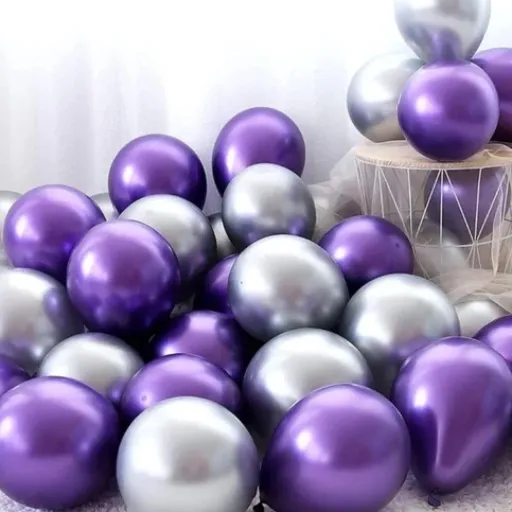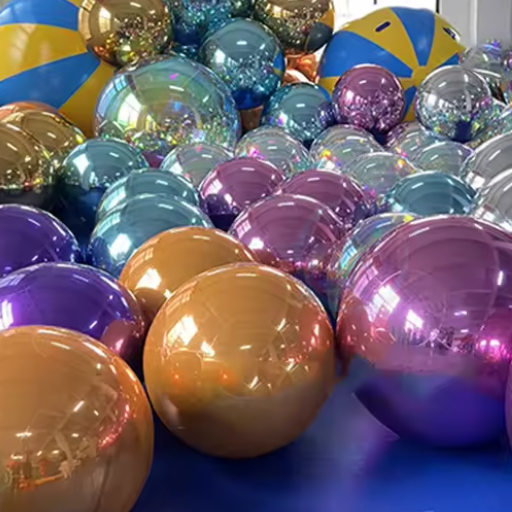Balloons have the power to turn any event into a wonderful festival, but have you ever questioned the duration of their lifespan? Whether you are hosting a party, creating an ambiance for an event, or just relishing the delightful balloons, knowing how long they will last can help you to make the most of your decorations. This article will explain the science of helium balloons… and will give you the factors that influence their time on the air, and also it gives you the ways of prolonging the life of latex balloon filled with either air or helium. The insights you will acquire by the end of this article will not only help you with the upcoming event but for any occasion to create your balloon experience in a magnificent way!
Introduction to Helium Balloons

The float lifespan of helium balloons can range from 8 to 12 hours or more depending on several aspects like the type and quality of the latex as well as the local atmosphere that can be either hot or cold. To keep them floating longer, proper care is to be taken likewise the use of hi-float treatments, or the balloons being kept in a cool place up to sometimes 2 days and this float time be extended significantly.
The Role of Helium in Balloons
Helium, with its exceptional physical and chemical qualities, is the main reason why balloons can float. Helium is still lighter than air and therefore balloons can easily ascend and drift in the air. Since helium is an inert gas, it will not react with other elements so that the balloon’s material can last longer. Nevertheless, the float time of balloons filled with helium is limited as the helium atoms are so tiny they can, over time, gradually pass through the balloon’s surface, and that way, helium will be gone.
The float time of helium balloons, on average, differs from one type of balloon to another and is also affected by atmospheric conditions in the vicinity. Standard latex balloons will float for about 12-24 hours while foil or Mylar balloons can last for about 3-5 days or more if sealed properly. Several studies show, for example, that combining high-quality latex with an innovative product like Hi-Float, which coats the inside of the balloon and slows the exit of the helium, can make latex balloons float for days.
Common Uses of Helium Balloons
Celebratory Events
Helium balloons are symbols of joy during events like birthday parties, weddings, and anniversaries. Their lightweight and vibrant characteristics make them very suitable for putting up decorations. Market analysts’ projections based on recent research suggest that the global market for party supplies which is quite inclusive of helium balloons will be around $33.66 billion in 2026, thus implying that these items are still very much in demand. The demand for specialty helium balloons, like foil balloons with custom printing, is particularly strong when people want to make their decorations special and unique.
Promotional Activities
Companies use helium balloons for marketing purposes quite often. Huge helium-filled balloons displaying logos or catchy phrases can really create the spotlight for events, shops, or new products. For instance, the use of helium balloons in outdoor advertising campaigns is very common as they help to attract audience from afar. Research shows that unconventional methods of advertising can even result in 15% more people coming to an event.
Scientific and Weather Research
Helium balloons are a must in many scientific applications. They are dispatched to the stratosphere with the help of weather balloons which are used to gather the atmospheric data about temperature, pressure, and humidity. NASA and weather bureau across the globe depend on helium balloons for conducting research in the upper atmosphere. One weather balloon that can go up to 100,000 feet easily collects tons of information that goes into weather prediction and climate research.
Properties of Helium and Their Influence on the Duration of Usefulness

The specific features of helium, including its very light and totally non-reactive character, play a huge part in its prolonged use in many areas. It is the main reason why helium is one of the best and most versatile elements for doing things like launching weather balloons or making scientific observations of the earth’s atmosphere. Thus, it is the chemical and physical properties of helium that are the main reasons for its efficiency and extensive use.
Characteristics of Helium
Hеlium is a gas that is colorless, odorless, non-toxic, and belongs to the noble gases group in the periodic table. It is the second lightest element in the universe and is known for its low density and inertness next to hydrogen. Its atomic number is 2 and its atomic mass is about 4.0026 u. The most interesting thing about helium is its stability that is, it does not combine easily with other elements or compounds because it has a filled outer electron shell.
One of helium’s most noteworthy characteristics is its incredibly low boiling and melting points, which are -452.07°F (-268.93°C) and -458°F (-272°C), respectively. This allows it to stay in the gaseous state over a wide temperature range at normal atmospheric pressure. This is very important for its many applications, for instance, it is used for keeping the superconducting magnets of MRI machines cool and also for helping high-altitude weather balloons work properly.
How the Diffusion of Helium Affects the Lifespan of Balloons
Balloons filled with helium are a widespread and cheerful decoration, but their lifespan is often curtailed by the diffusion of helium through the materials of the balloon. This helium diffusion is a natural process when helium atoms escape through the balloon’s pores because of the smaller atomic size of helium compared to that of other gases. The process is slow but continuous for helium that is trapped in latex or foil balloons, where helium gets eventually reduced and this results in the gradual deflation of the balloon.
The extent of helium diffusion is mainly dependent on the kind of balloon material used. For example, latex balloons, which are filled with helium, can last around 12 to 24 hours, whereas foil (or mylar) balloons are able to keep helium for a much longer period, often even 3 to 5 days or more are they still floating. The difference in the balloon’s life span is due to the fact that latex is a more porous material as compared to the denser and less permeable foil material.
Factors Influencing the Duration of Helium Balloons

In my opinion, the lifetime of helium balloons is determined by the kind of material they are made of. Latex balloons can usually hold helium for a period of 12 to 24 hours, while foil or mylar balloons can stay up to 3 to 5 days or longer because they are less porous and so they trap helium better.
Material Differences: Latex versus Mylar Balloons
Latex Balloons
Latex balloons are composed of rubber and thus are natural creations and not destructive to nature. Unfortunately, the microscopic holes in their surface allow helium to escape rather fast. Under normal conditions, a helium-filled latex balloon will float for a period of 8 to 12 hours, but using Hi-Float or any other similar product can prolong the lifetime of the balloon to 24 to 48 hours as a seal is created inside the balloon. The main reasons people buy latex balloons are low price, brilliant colors, and easy personalization.
Mylar Balloons
Mylar balloons consist of a thin, flexible layer of metallic polyester film and are made of a material that is one hundred times less porous than latex. These balloons are very efficient in retaining helium -they have an average float time of 3 to 5 days- and in some cases last up to weeks when sealed and stored properly. Mylar balloons are recognized for their stunning, reflective surface and beautiful designs, which makes them perfect when large gatherings or personal messages are involved.
Environmental Conditions that Affect Balloon Life
Balloons are very much affected when it comes to their life span by different environmental factors, and this impact is more pronounced when the balloons are used in open areas. Latex balloons are prone to being affected by environmental conditions as they are biodegradable. Their life span is majorly determined by temperature, sunlight, and humidity. The direct sun with ultra-violet (UV) rays will see the latex balloon deflate, turn weak, and eventually disappear within 12-24 hours as the rubber will be degraded. On the other hand, the Mylar balloons with their metallic outer layer are resistant to UV rays and hence can last for several days outdoors maintaining their structure and helium content.
Fluctuations in temperature are also a crucial factor. Hot weather can make the helium to expand in the case of latex balloons, thus increasing the likelihood of bursting, whereas cold can make the helium to contract resulting in the balloons being deflated or sagging. According to the recent research Mylar balloons are the most stable when the ambient temperature fluctuates making them the best option for places with variable weather conditions.
How to Inflate Balloons That Lasts Longer

Use the Right Gas
Although helium is the gas that is mostly used for floating balloons, it is also the one that tends to escape through the latex in no time. For that reason, to make the duration last, use the best helium with Hi-Float which is a solution that is made to coat the inside of latex balloons and hence, minimizing helium leakage. Studies have shown that Hi-Float can make the floating time 25 times longer than just helium. For air-inflated balloons, make sure a pump is used so that the air comes in at the same frequency throughout.
Avoid Overinflation
Overinflated balloons are susceptible to busting because the latex becomes too thin, particularly in regions with warm climate. The packaging comes with the recommended sizes to which you should inflate balloons. For instance, a standard 11-inch balloon should be inflated to approximately 10-11 inches in diameter. New modern inflation tools that come with built-in gauges can now make it easy to ensure accuracy.
Take into Account the Environmental Conditions
Environmental conditions hugely impact balloon longevity. It is, therefore, prudent to keep balloons in cool, shaded areas as high temperatures or UV rays can drastically reduce their durability by as much as 40%, according to environmental materials research studies. Air conditioning indoors slows the helium leak while outdoors more precautions are needed.
Expert Insights and Recent Research Findings

Case Studies on Balloon Longevity in Various Conditions
Case Study 1: Balloon Longevity in Indoor Environments
The research shows that in indoor controlled environments ballerina helium balloons last much longer than outside. The latest experiment in a climate-controlled room (temperature of 72°F and relative humidity of 50%) is a good example of this. It was found that latex balloons that had been treated with Hi-Float could stay aloft for 48 hours but those that were not treated lasted only 14 hours on average. The situation was different for foil balloons which were able to float for as long as five days even under the same conditions. The controlled temperature and absence of direct sunlight were two reasons for preventing helium leakage and material degradation to a lesser extent.
Case Study 2: Effects of Outdoor Conditions on Balloons
The outdoor conditions present a challenge for the balloon’s lifespan. A field experiment gave the data that direct sunlight, wind, and temperature changes can significantly lower the latex balloon’s helium retention rate. For example, untreated latex balloons completely deflated in just six hours when the temperature was at 85°F and UV exposure was high. On the other hand, Hi-Float treated latex balloons could last up to 10 hours roughly the same time as untreated balloons under similar conditions. Then again, foil balloons proved to be more resilient as they managed to stay afloat for 2-3 days despite the continuous sun. The study has shown that coatings are one solution and the timing of inflation is another for outdoor events.
Recent Studies on Helium and Balloon Materials
Recent studies have clarified the way helium behaves and how different balloon materials perform under changing conditions. The research that has been published in material science journals claims that latex balloons, because of their porous structure, lose helium quicker than foil (mylar) balloons. For instance, the data reveals that the life of helium in a latex balloon under standard conditions is about 12 to 24 hours; in comparison, a mylar balloon can hold helium for several days that can be extended to a week or more if properly sealed.
Another aspect of the helium diffusion process was brought to light by a study conducted by the American Chemical Society which discussed the effect of environmental factors like temperature and humidity on the helium diffusion rates. At higher temperatures, the balloon material molecules expand which makes it easier for helium leaking. A case in point is the testing which showed that latex balloons suffered a 30% faster deflation rate when exposed to temperatures above 86°F (30°C). In contrast, cold conditions can cause helium to contract thus temporarily losing buoyancy. Nevertheless, balloons usually return to their original shape and lift when reintroduced to warmer air.
Reference Sources
-
Party On Butler Blog
This blog provides insights into how long helium balloons last, factors affecting their lifespan, and tips for maintaining their appearance during events.
Source Link -
Helium FAQs by Helium 10
This FAQ section addresses common questions about helium, including its usage and longevity, offering a practical perspective for readers.
Source Link -
Helium SEO Content Marketing
While primarily focused on content marketing, this source discusses helium’s relevance in engaging audiences, which can indirectly validate its importance in various contexts.
Source Link
Frequently Asked Questions (FAQs)
How long do helium balloons usually stay in the air?
Helium balloons usually float for about 8-15 hours. The floatation time, on the other hand, depends on some factors such as the balloon material and surrounding conditions. Latex balloons have a short flotation time compared to foil balloons while the latter can even be inflated up to a week with proper management.
What suggestions are there for prolonging helium balloon life?
One to two years if helium balloons are well treated, so you can apply a sort of balloon treatment that slows down the helium loss. Besides that, if you store the balloons in a cool place and away from direct sunlight and high humidity then a significant amount of the balloon’s life and good looks will still be left.
Why do some balloons lose their air quickly?
Temperature variations, humidity, and direct sun are among the major factors that make balloons lose their air quickly. If you are aware of all these factors, you would be able to control the inflating period of the balloons.
Can helium balloons float for a month?
Even if it is not the very common, yet some types of foil helium balloons can float for a month or more if they are properly taken care of. The choice of the balloon and the maintenance rituals can influence the duration of the helium balloons’ life.
How do I keep latex balloons alive for a longer period?
It is very important to keep the latex balloons away from cutting tools and extreme temperatures. One can also use a balloon sealant to slow down the helium leak rate and thus keep the latex balloons looking their best for longer.
Is it true that the way a balloon is inflated affects its longevity?
Indeed, the inflation method has a lot to do with how long the balloons will last. Over-inflation will put the material under a lot of strain and hence will be prone to faster leaks while inflating them just to the specified size will even help them live longer.
Now you’re equipped with all the knowledge to make your helium balloons last longer and create unforgettable celebrations!










